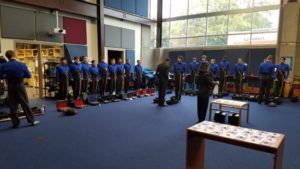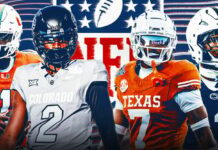Friday Night Life of a Band Member
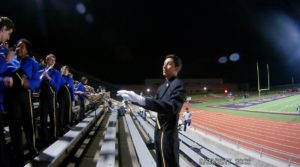
Everybody knows the football team’s routine every Friday night: have a good meal a safe distance from warm-ups, a light warm-up to get loose, a classic encouraging pre-game talk, and then charge onto the field to kick off the game.
However, far fewer know the Friday night routine of a band member. While the band is there for every game and always sporting blue and gold uniforms, the audience often ignores them, except when someone recognizes a song or a cadence and goes, “Oh I love this one!” But what goes down in a normal Friday game night for the band? In this article, I will walk you through an in-depth view of what a band member would experience on an average week.
Inspection
The process begins with a call time to get changed into uniform. The call time can be anywhere from the 4:00 to 6:00 depending on the distance of the game and the warm-up time required. Inspection is strictly enforced and very important. If a band member is not in the position with his correct uniform, his instrument ready and working, and his various requirements such as a water bottle, he is considered late and will be deducted points. Once called to attention, the band members must hold this rigid position without moving for up to ten minutes at a time. Once inspected, they are allowed to relax into a parade rest until dismissed by the directors.
Warm-Ups
For the band, it is important to make a good first impression the moment they step onto the track, so warm-ups are just as important as the game. Like the warm-ups the football team does before every game, the band always warms up. It is not as intense as football, but it prevents any possible injury from things like having your toes too high while marching. The band also syncs together in the morning by doing drills such as 8 to 5(the number of steps over a five-yard distance) marching to a specific tempo. Along with the marching warm-ups, scales are necessary for getting your body ready to play. The scales open your windpipes and allow you to set your embouchure(the structure you have to set your lips to play the note) for the coming songs. Along with the scales, the band might play a few stand tunes to give a little practice to perfect what comes out in the stands. Depending on the morning a normal warm-up may last five to twenty minutes. After warm-ups are finished, it is out to the field to play for the Rangerettes and memorize the sets in the marching show.
Track March
The track march is vital to the band. It is how we get from one place to another while still looking awesome. The track march involves organizing the band into rows of two, three, or four depending on section size. In the first couple of rows is the color guard waving banners or flags. Next, comes the trumpets and mellophones (French horns), followed by the low brass including trombones, euphoniums, baritones, and sousaphones. Behind them is the drum line consisting of snares, tenors, and bass drums. The bass drums are the heart of the track march and the band as they keep the beat and mark the time for us to follow. Behind the bass drums come the saxophones lead by the baritone and tenor saxophones and then the altos. Bringing up the rear are the flutes and clarinets. Every game, after warm up, we line up in the track march alongside the Rangerettes behind the Terry center. The drum majors count the drums and we’re off. We march into the stadium from the front gate and do an entire lap around the track. While marching, we play multiple cadences and stand tunes including the fight song and la-me.
Stand tunes
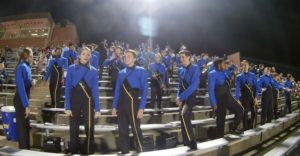
Around eighty percent of the band’s night consists of playing stand tunes in cadences. Stand tunes are pretty self-explanatory. They consist of the parts of or whole songs. Some of the most popular cadences among the band are Conga, Vehicle, 25 or 6 to 4, Handclap, and Crazy Train. In between stand tunes, the drumline solos, playing cadences. While the drum plays their cadences, the band usually does some kind of move/ dance in time with the cadences. The stand tunes are the most difficult for the trumpets. As the trumpets are tasked with the high notes and melody of the piece, their chops (lip muscles) often wear out before halftime. To prevent this, the trumpets will take turns sitting out of the stand tunes. One of the most important things about the stand tunes is the timing in which we play them. We never play stand tunes on offense so we do not risk messing up the rhythm of play or knocking somebody off their game. Also, if you watch the band during touchdowns when the Rangers score near where we are playing, we will immediately get really quiet so as to not bother the kicker. The only times we are not playing stand tunes or cadences are on offense, during halftime, or on break.
Here are some of the band’s favorite stand tunes
Rachel Pierce, Uniform Lieutenant, – Bad Romance
Sam Eppich, Drum Major, – Vehicle
Luiz Lopez, Vice President, – 25 or 6 to 4
Will Gasper, Low Brass Captain, – Conga
Injury Procedure
As is accustomed to football, there is around at least one injury per game. The band responds to this by immediately stopping playing and holding up one of their arms to cross their fingers as a sign of respect. The band does this for any injury on either team. Then when the player gets up off the ground, the entire band claps for him.
Halftime
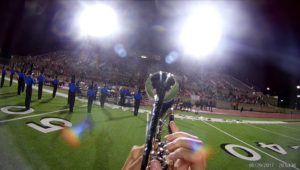
The halftime show is the climax of the evening for the marching band. The seven minutes, while we are on the field, represents hours of practice and effort put in five days a week every week. In the band, the halftime show begins at the eight-minute mark in the second quarter. The eight minutes mark when we put on our full uniforms, including gloves gauntlets and hat, and plumes, the fuzzy things that stick out of our hats. Once suited up, we head down the bleachers to the turf area behind the bleachers where we sit. Once here, we congregate into the warm-up arch and wait until the archive lieutenants pass out the music for the Rangerettes. Then Mr. Crownover will call the band to attention and begin our warmup music, scales, and other exercises. Once warmed-up, the band will usually run through the show beginning to end. The interesting thing about our warm-ups is that at random times, Mr. Crownover will call the band to sing instead of play to save the chops(muscles used for embouchure and to play the instrument) of the trumpets and others. After running through the show, we get into a formation called the Rangerette block. This set gets the band on the field at halftime while still getting us into formation for the Rangerette set. Once in position, we watch as the Rangerettes get into their own spots.
It begins. The drumline taps off the drum majors, band, and Rangerettes. On cue, the drum majors blow their whistles six times to mark the step off of the band. The band marches in time listening to the drumline and the announcer introducing the Rangerettes up to the visitor hash marks. Once the drumline brings the band to a halt, the band allow for the drum majors and Rangerettes to get set in their positions. The drum majors call for horns up and in unison 80 instruments come up into position. The drum majors count off “1 … 3 …. 5, 6, 7, 8!!!” Listening, the band comes in together and begins whatever song that the Rangerettes have picked out for the week. While not part of the halftime show. The Rangerette tune gives off the first impression of the band, starting with the first note. Once the Rangerettes finish their piece, the band drag turns four counts facing their spots and then goes to their first positions in the opener. This is the first time a new band member really feels the adrenaline of performing in driving lights and in front of a thousand or more people. The goal of the experienced band member is to be able to march the show beginning to end with high toes, exact precision, good dressing (staying in line), while staying in time, all without truly thinking about it. This is because, the fear makes you forget certain elements of the show, so it is best to have it so ingrained into the back of your mind, it is impossible to forget or blank out on the moves. Once the show is over, the band drag turns to go to the JCP formation. In this set, the band faces whichever side Jesuit is on and plays the fight song to the sounds of the fans clapping in time. As the fight song ends, the band drag turns to whichever direction the drum majors point and marches off the field.
Here are the band’s favorite movements
Rachel Pierce, Uniform Lieutenant, – Movement Five: 1812 Overture/ Stars and Stripes forever
Sam Eppich, Drum Major, – Movement Five: 1812 Overture/ Stars and Stripes forever
Luiz Lopez, Vice President, – Movement One: Fanfare for the Common Man.
Post Halftime
Once the band returns to the stands, they are given a break to allow for the wind players to rest their chops and eat a snack, as they might not have eaten anything since four in the afternoon. After the break, we usually go back to playing stand tunes. A custom that most of the bands have is whoever, the home team is, invites a member of each section of the opposing band over to introduce themselves. They are asked questions like, “what is your name/ favorite color/ favorite cereal/ favorite candy/ favorite Denzel Washington movie/ relationship status? What kind of kitchen utensil are you?” The band’s favorite question is they will ask whether or not the person is single, the drum line will give a big drum roll, and if the answer is single, the entire band cheers really loudly. The final stand tune that the band plays every game is Sweet Caroline. Once the game is over, the band plays the alma mater and fight song.
Dismissal
Once the band track marches back inside the band hall, they put their instruments away and wait for the dismissal from the directors and drum majors. The directors will give them a speech about what they did well and what they need to work on. Then they will hand it over to the drum majors who will dismiss the band through a series of chants.
| Drum Majors | Band |
| Da da da da Band-ten-hut
The Word of the day is success
Band!! Drill the positions of attention!!!!
Feet!
Core!
Shoulders!
Chest!
Head!
Eyes!
Eyes!
Eyes!
Who are we??!!!
Who are we??!!
Who are we??!!!
Band Dismissed!!!
At Ease!!! |
Hut!!!!
Together!
Tight!
Back!
Out!
Up!
With Pride!!!
With Pride!!!
With Pride!!!
Ranger Band!!!
Ranger Band!!!
Ranger Band!!!
Success Majors!!!!
Woohoo!!!! |
Following the dismissal, the band will usually watch the film of the halftime show and comment on how they did, but their night is done. You can watch the band perform weekly by subscribing to Jesuit Muse on YouTube.
Here is why people love being in the band.
Rachel Pierce, Uniform Lieutenant, – “I love everything about it. Band is where I’ve met some of my best friends and coming together to create something special and unique to each year’s band is my favorite part”
Sam Eppich, Drum Major, – “I like how a lot of people who may or may not have anything in common come together to create a moving living work of visual and auditory art. There’s something incredibly unique and rewarding about that kind of teamwork that I haven’t seen anywhere else. The common goal we all share is something I’m proud of, and I’m proud to be a part of this organization.”
Luiz Lopez, Vice President, – “Enjoying music while being with my friends.”



